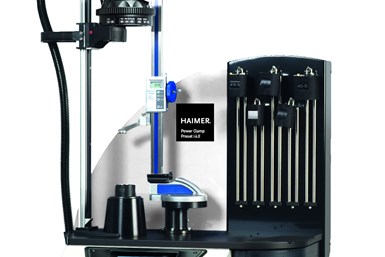Video Tech Brief: Shrink-Fit Collets Explained
For live-tool lathes, shrink-fit collets can speed setups while offering higher tool clamping forces.
Manually measuring tool offsets is a time-consuming process. Haimer says it commonly takes 300 seconds per tool to measure a tool in a machine. Plus, when using a machine tool as the “presetter,” an expensive piece of equipment is not doing what it is supposed to be doing — making chips. The company says this time can be reduced by 70% using an offline tool presetter to automatically measure attributes such as tool height, diameter and runout.
Even entry-level presetters can support as many as 10 machine tools. In fact, Haimer has 140 machine tools in its 200,000-square-foot German manufacturing facility in Igenhausen, near Augsburg. In the main tool crib is
Haimer’s Power Clamp Preset i4.0 offers shrink-fit technology for ER collets for live-tool lathes. Photo Credit: Haimer USA
a Vio Linear full CNC tool presetter. However, when a tool breaks on a machine far from the tool crib, the operator can choose to use one of 10 Uno Smart tool presetters installed throughout the facility to change one tool rather than walking to the tool crib.
For live-tool lathes, presetting complements the company’s new line of shrink-fit collets that enable faster changeovers for those types of machines than conventional collets, too.
Learn more about shrink-fit technology for live-tool lathes in this article.
Related Content
-
Machining’s Impact on Sustainability
Individual elements of the machining process such as machine tools, tooling and even CAD/CAM software play a role in overall machine shop sustainability. Observing the entire process especially when it comes to their influences on energy usage is key.
-
Micromachining Fundamentals
A number of elements must come together to establish an effective process for machining at a micro level. Here we consider four.
-
Automation Breakthroughs Revolutionize Precision Machining for Complex Parts
Marubeni Citizen-Cincom delivers custom solutions to address some of the biggest challenges in precision machining from handling small parts, to robot integration and unique tooling needs.














.png;maxWidth=300;quality=90)
.png;maxWidth=970;quality=90)